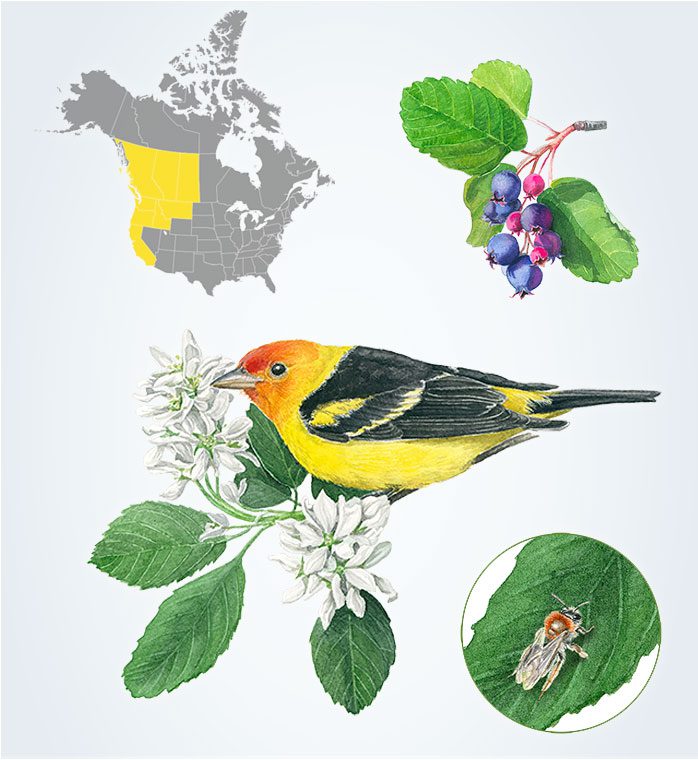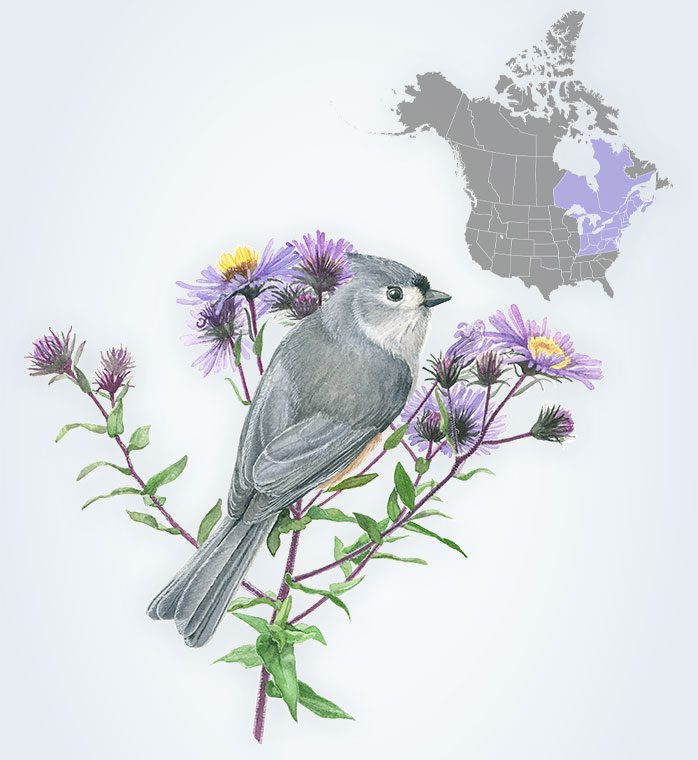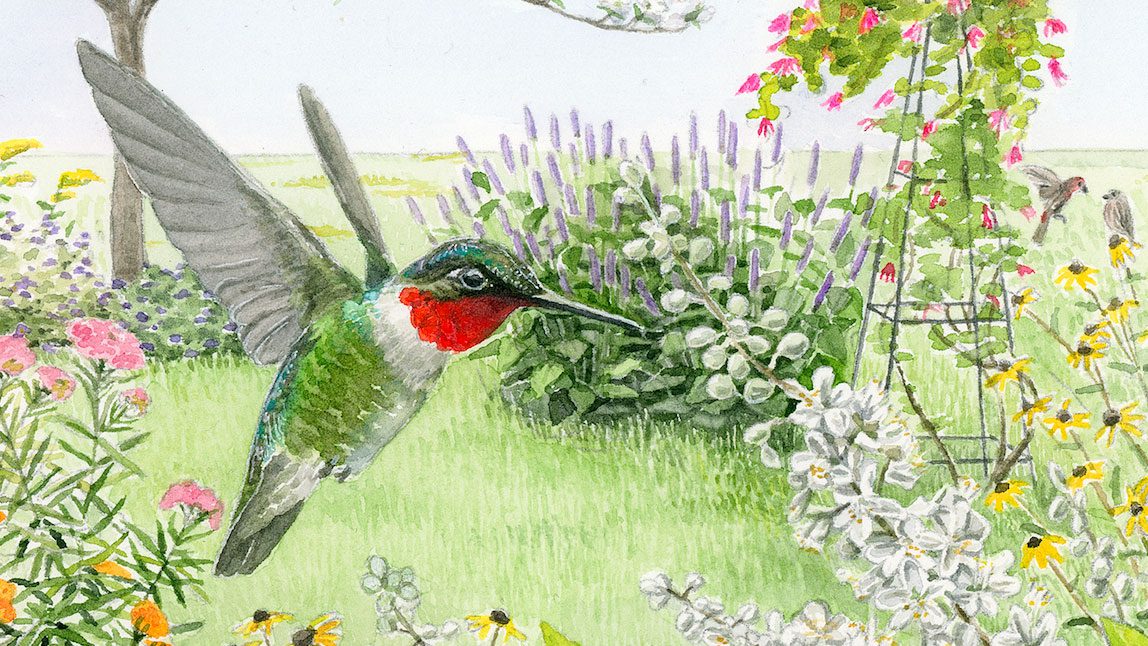
From the Summer 2024 issue of Living Bird magazine. Subscribe now.
One way to get close to birds is to look for the plants that feed them. In spring, Red-eyed Vireos, Yellow Warblers, and hosts of other songbirds nab caterpillars by the dozen off emerging white oak leaves, while Cedar Waxwings and Gray Catbirds seek out sweet purple serviceberries. Summer takes hold and Ruby-throated Hummingbirds sip the nectar of wild bergamot, while Anna’s Hummingbirds gulp from California fuchsia. Come fall, flocks of American and Lesser Goldfinches feed on the seedheads of black-eyed Susans and common sunflowers. Throughout the winter American Robins and Northern Mockingbirds pluck hawthorn and winterberry fruits still dangling from bare branches.
When you see a bird on or around one of these native plants in your yard or neighborhood, it’s more than a coincidence, says Cornell Lab of Ornithology native plant specialist Becca Rodomsky-Bish, project leader for the Great Backyard Bird Count: “These are all plants that have grown here for millennia, and they have the positive ecological impact to show for it. If you love supporting birds and seeing them up close, then you can make a huge contribution to them and to yourself by growing these kinds of plants.”
Doug Tallamy—professor of agriculture and natural resources at the University of Delaware, and author of the native-plants-landscaping book Bringing Nature Home—has spent decades documenting the strong connection between native plants and healthy bird populations. In 2009, Tallamy and his team found that yards in southeastern Pennsylvania filled with mostly native plants—including ground cover, shrubs, and trees—hosted four times as many caterpillars (a key food source for breeding birds) as yards with non-native vegetation. In the same study, bird species of regional conservation concern, such as Wood Thrush and Blue-winged Warbler, were found eight times more often on those native-plant–laden properties. That same year, Tallamy and his team published a Lepidoptera Index that ranked nearly 1,400 plants from the mid-Atlantic region in terms of how many caterpillar species they support. Big winners included native oaks, cherries, birches, and willows.
In a 2017 study published in the journal Biological Conservation, ecologist Desiree Narango joined with Tallamy to examine the dietary needs of Carolina Chickadees breeding all around the southeastern U.S. She and her team found that the birds mostly avoided foraging and nesting in yards with a high proportion of non-native plants, even when nest boxes were available. In that study, chickadees raised more fledglings in yards with mostly native plants; in yards with primarily ornamental, non-native plants, many chickadee nests failed because there wasn’t enough for the nestlings to eat.
Native plants “help maintain or recreate ecological systems and food webs that have evolved over thousands of years to allow birds and biodiversity to thrive,” says Rodomsky-Bish of the Cornell Lab. “Those insects and their caterpillars are just not going to be there if they don’t have the right kinds of plants.”
Native plants also provide more than caterpillars and insects. They are a direct nutrition source for birds in the form of buds, fruits, and seeds. And many—from the tiniest grasses to the tallest oaks—provide places for birds to build nests and find shelter. Benefits like these mean bird populations can thrive year-round in native-plant-dominated landscapes. A 2023 study published in the journal Ecosphere by Cal State Los Angeles ornithologists Noriko Smallwood and Eric Wood showed that native plants can boost bird populations in the nonbreeding season. Bird richness and abundance—how many species were found, and how many total birds were present—both spiked in winter in Southern California yards that were around 80% native plants.
Marla Coppolino, an ecologist who helped develop the online course Growing Wild: Gardening for Birds and Nature for the Cornell Lab’s Bird Academy, has some advice for people who are excited about transforming their yards for the benefit of birds but aren’t sure where to start.
“Gathering local knowledge is important,” says Coppolino, which could mean anything from talking to your neighbors with gardens to researching your ecoregion and microclimate. “It’s really important for beginning gardeners to understand the nuances of their local spot.”
To that end, Coppolino recommends knowing the right kinds of questions to ask yourself (or at your local plant nursery) if you’re thinking about how to turn your yard into a native-plant paradise.
First, she says, take stock: Assess your outdoor space and get acquainted with your USDA plant hardiness zone. What plants are growing already? Are you planting in sunny spots or shady spots? Have you identified wet and dry areas? Does the spot have good drainage?
Then think about your goals: What birds or other wildlife are you hoping to attract? What kind of native plants do you want to put in—ground cover, shrubs, trees, vines, or some combination? Do you have aggressive plants you’d like to remove?
Coppolino says fall is a great time to plant native perennials because the soil is warm and there tends to be a lot of moisture: “That helps plants establish and gives them a head start when spring rolls around.” Plus, she says, autumn is when “nurseries usually have some good sales!”
Rodomsky-Bish adds that people shouldn’t be too worried about getting their entire property planted with natives: “The research shows that if you can get your space to around 70% natives, then you’ll see most of the benefits to birds and other wildlife.”
A Primer for Native Plants for Birds in North America


North-Central United States and South-Central Canada
The Midwest and Great Plains are where the continent transitions from forests to prairies, so consider including grasses and other herbaceous plants in your planning. Switchgrass (Panicum virgatum) and little bluestem (Schizachyrium scoparium) can provide nesting habitat for ground-nesting birds like sparrows and Northern Bobwhite. In summer these grasses, and early-fall-flowering plants such as common sunflower (Helianthus annuus) and gray goldenrod (Solidago nemoralis) attract insects that attract nesting songbirds, and their seedheads offer a fall and winter food source for Indigo Buntings, sparrows and year-round residents like chickadees and titmice.


Northwestern United States and Western Canada
From coastal rainforests to the plateaus and valleys that roll eastward from the mountains to the plains, the northwestern U.S. and western Canada span a range of climate types. Smaller trees and shrubs such as Saskatoon serviceberry (Amelanchier alnifolia) and red twig dogwood (Cornus sericea) provide shelter and fruits at different times of year to attract birds like American Robin and Western Tanager. Perennials like California fuchsia (Epilobium canum) and wild bergamot, or beebalm (Monarda fistulosa) attract hummingbirds.


Southwestern United States
In the arid and semi-arid Southwest, native plants can help wildlife and help conserve resources since plants of the region are typically used to surviving on limited water. Blanket flower (Gaillardia pinnatifida) and California fuchsia (Epilobium canum) are two flowers that add a bright spot to the landscape while attracting Anna’s, Rufous, and other hummingbird species. Common juniper (Juniperus communis) and desert holly (Atriplex hymenelytra) are deer-resistant shrubs with hardy fruits sought out by Townsend’s Solitaires and Cedar Waxwings. Also remember that Southern California and the rest of the Southwest have their own suite of native oak trees to consider, along with a host of native cacti.


Southeastern United States
The southern Appalachians, Piedmont plateau, and expansive coastal plains of the Southeast are home to a greater diversity of native plant species than any other region in the U.S. Shrubs such as highbush blueberry (Vaccinium corymbosum) and American holly (Ilex opaca) draw in Gray Catbirds and Eastern Towhees through midsummer, while the vining coral honeysuckle (Lonicera sempervirens) is a Ruby-throated Hummingbird magnet. Black-eyed Susan (Rudbeckia hirta) and purple coneflower (Echinacea purpurea) produce seedheads chock-full of tasty morsels that attract American Goldfinches and House Finches in the fall and winter.


ludovicianus) perched on a flowering dogwood (Cornus florida).
South-Central United States
There are a host of ecoregions contained in the south-central U.S., stretching from the wide and wet Mississippi Plains, through the Ozarks and the hills of Texas, to the southern Great Plains. Northern spicebush (Lindera benzoin) is a shrub that grows well in moderate climates, bearing bright red fruits that birds like Blue Jays and Scarlet and Summer Tanagers seek out in the fall. The same goes for the red fruits of the small to medium-sized flowering dogwood tree (Cornus florida), which also has bright white blossoms that are a showstopper in the spring. Wild bergamot (Monarda fistulosa) is perfect for attracting several hummingbird species, and the bright orange butterfly weed (Asclepias tuberosa) is a non-aggressive milkweed that serves as a host for caterpillars and other insects, which make for tasty treats for warblers, vireos, and other insectivores.


Northeastern United States and Southeastern Canada
From New England to the mid-Atlantic, northern Appalachia, and parts of the Midwest, you can plant trees like willow, cherry, birch, and oak—species that top the list for hosting juicy caterpillars. Swamp milkweed (Asclepius incarnata) also attracts loads of insects that hungry birds will feed on in spring and early summer, and provides nesting material for American Goldfinches later in the season. A patch of New England asters (Symphyotrichum novae-angliae) can provide cover for nestlings in the summer, beautiful purple flowers in early fall, and a wealth of seeds that nuthatches, cardinals, and other seed eaters seek out in the winter.
llustrations by Bartels Science Illustrator Charlotte Holden; maps by FreeVectorMaps.com.

